2
First author contact:
Received:2021-08-30Revised:2021-10-18Accepted:2021-10-22Online:2021-11-23

Abstract
Keywords:
PDF (625KB)MetadataMetricsRelated articlesExportEndNote|Ris|BibtexFavorite
Cite this article
Zhuoxuan Xie, Ruilin Han. Flavor-dependent photoproduction in heavy-ion collisions. Communications in Theoretical Physics, 2021, 73(12): 125301- doi:10.1088/1572-9494/ac3231
1. Introduction
A lattice quantum chromodynamics (QCD) simulation proves the existence of a new phase of matter within high-temperature regions known as quark-gluon plasma (QGP) [1]. And this phase transition can be realized in the experiments by relativistic heavy-ion collisions carried out at the Relativistic Heavy Ion Collider (RHIC) and the Large Hadron Collider (LHC). Recently theoretical studies show that non-central relativistic heavy-ion collisions can generate a strong magnetic field [2, 3]. The maximum of the magnetic field can reach ${eB}\sim 5{m}_{\pi }^{2}$ for semi-central Au+Au collisions at RHIC 200GeV and $\sim 70{m}_{\pi }^{2}$ for semi-central Pb+Pb collisions at LHC energies [3]. The existence of a strong magnetic field in QCD matter induced so many spectacular phenomena, such as magnetic catalysis (MC) and inverse magnetic catalysis (IMC) [4, 5], chiral magnetic effect (CME) [6], enhancement charge particles elliptic flow [7, 8] and so on. In the heavy flavor sector, the strong electromagnetic fields produced in heavy-ion collisions not only affect the heavy quark (quarkonium) production and evolution [9–12] but also induce direct electromagnetic production. Actually, the electromagnetical production has been studied in ultra-peripheral nuclear collisions where the hadronic interaction can be neglected safely [13–16]. However, the magnetic field increase with impact parameters firstly and then decrease until ultra-peripheral nuclear collisions (UPC), which also reaches a maximum at impact parameters ∼12 fm(<2RA, with RA is the radius of nucleus.) [3]. In recent experiments it was also indicated that charmonium photoproduction becomes larger than the hadroproduction in the extremely low pT region even in the semi-central collisions at RHIC [17, 18] and LHC [19].On the theoretical side, Fermi firstly proposed that the transverse electromagnetic fields can be approximated as a swarm of equivalent photons, called 'Equivalent Photon Approximation' (EPA) [20]. This idea was also extended by Weizsäcker and Williams independently and is therefore also called the 'Weizsäcker-Williams-Method' [21]. This allows a simple and straightforward calculation of photoproduction between the target nucleus and electromagnetic fields [22–24]. Comparing the wavelength of the equivalent photon with the nucleus size, the photoproduction can be divided into coherent and incoherent photoproduction. In the case of coherent photoproduction, the wavelength of the equivalent photon is larger than the nucleus radius and the photon interaction with the whole nucleus [25–30]. If the wavelength of the equivalent photon is short enough to distinguish and then the nucleons or even partons in nucleons, this is known as incoherent photoproduction [31, 32]
Unlike the photoproduction at UPC, one may need to consider both cold nuclear effects [33–36] and hot nuclear effects [37–42] in the peripheral hadronic heavy ion collisions (HHIC). As studied before, the photoproduced produced J/ψ will be partly dissociated in the hot medium and regenerated in the final stage [25]. For strange quarks, their thermal production in hot medium via, for instance, the gluon fusion process ${gg}\to s\bar{s}$, can largely increase their number. It was proposed as a signal of the QGP formation [43]. Due to the strangeness enhancement, the photoproduced φ meson would be not evident comparing with J/ψ.
The paper is organized as follows. After a short introduction to photoproduction, we present the density of the equivalent photon and photoproduction formulas in section
2. Theoretical framework
The energy flux of the electromagnetic field through a plane perpendicular to the moving direction of the nucleus is described by the Poynting vector S = E × B. And based on the spirit of the EPA method, the energy flux of the fields through a transverse plane is identical to the energy flux of the equivalent photons, that are also required by energy conservation law. So, the photon flux at a distance r from the central of nucleus is given by [22, 44, 45]:For the coherent photoproduction, the photon emitted from nucleus A interacts coherently with another nucleus B. We average the photon density over nucleus B. The photon density at certain point r and the averaging value is shown in figure 1.
Figure 1.
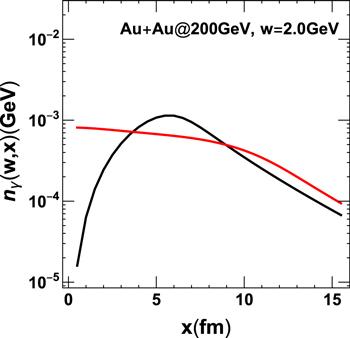 New window|Download| PPT slide
New window|Download| PPT slideFigure 1.The comparison of photon density as a function of distance with/without average over nuclear. The red line represent the average value, while the black is without averaging.
We can see the profile of the photon density before averaged over another nucleus increase firstly, then decreases continually, and reaches a maximum at x ∼ 6fm as the distances get larger and larger. While the photon density monotonically decreases after the average. That means the contribution of photoproduction becomes more and more important from peripheral to central collisions.
The Woods-Saxon distribution for symmetric nuclei:
With the photon density and the photon-nucleus cross section, we can write the vector meson coherent photoproduction cross section as a function of rapidity in UPC as,
The transverse momentum distribution of photoproduced vector meson can be expressed as (consider $t={p}_{T}^{2}$):
3. J/ψ production
Figure 2 shows the coherent photoproduction cross-section of J/ψ at RHIC in UPC. It can explain the experimental data well. For J/ψ, they are tightly bounded $c\bar{c}$ state, the probability survives in the hot medium produced in heavy-ion collisions. And previous studies show the final yield of J/ψ comes from two parts, initial production and regeneration [42]. For the peripheral hadronic heavy-ion collisions, there is another part, photoproduction. Those three contributions will be accounted and calculated in the following.Figure 2.
 New window|Download| PPT slide
New window|Download| PPT slideFigure 2.J/ψ coherent photoproduction cross section as a function of rapidity in UPC at 200 GeV Au + Au collisions. The experimental data is from [49].
We firstly concentrate on the initial hadroproduction. The differential cross-section of the J/ψ hadroproduction in p + p collisions has been measured in the experiment [50, 51]. And it can be parameterized as [52, 53]:
Figure 3.
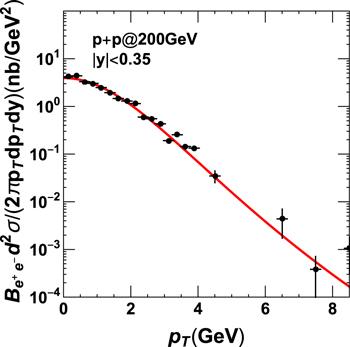 New window|Download| PPT slide
New window|Download| PPT slideFigure 3.The differential cross section of J/ψ in 200 GeV p + p collisions at central rapidity. The line is our parameterization with equation (
Now, we come to consider the cold nuclear effect in heavy-ion collisions. For the charmonium production, the cold nuclear matter effect includes usually the nuclear shadowing effect, Cronin effect, and nuclear absorption. At top RHIC energy, the collision time is much shorter than the charmonium formation time and also the formation time of QGP, one can safely neglect the nuclear absorption and just take into account the Cronin effect and shadowing effect [38, 39]. The Cronin effect will broaden the momentum of the initially produced charmonia. The shadowing effect will introduce a modification factor for primordially produced charmonium which is roughly ∼0.8 and dependent on the impact parameter [36].
The hot medium named quark-gluon plasma which is produced in heavy-ion collisions is a very strong coupling system. The evolution can be described by the hydrodynamic equation. For simplicity, we solve the (2+1) D ideal hydrodynamic equations [39] to get the local temperature T(x, τ) and four velocity uμ(x, τ). One also needs the equation of state of the hot medium. We treat the quark-gluon plasma as an ideal gas of massless gluons, u and d quarks, and strange quark with mass ms = 150 MeV [54]. Hadron gas is taken to be an ideal gas of all known hadrons and resonances with mass up to 2 GeV. The connection between two phase is constructed with Maxwell law. By changing the initialization for the hydrodynamic equations, we obtain the maximum temperatures T0 = 320 MeV of the medium at the initial time τ0 = 0.6 fm/c for 200 GeV Au + Au collisions.
The real-time evolution of J/ψ in hot medium can be described by the Boltzmann equation. And give a good description on J/ψ nuclear modification factor RAA, anisotropic flows and so on [37–41]. Charmonium dissociation and regeneration rates are proportional to the parton local densities and the charm pair densities in the hot medium, respectively [55, 57, 58]. However, it's difficult to determine the position of J/ψ in a coherent photoproduction process. We aim to consider the modifications of cold and hot matter on photoproduced J/ψ, so we need to know the spatial distributions of them. In this work, we take the spatial distributions fnorm as a function which is proportional to the square of the thickness function ${T}_{A}^{2}({{\boldsymbol{x}}}_{T})$.
The results which contain those three contributions are shown in figure 4. We can see clearly, the photoproduced J/ψ is mainly in the low pT(<0.1 GeV) region and largely enhanced compared with hadronic production. This is a clear signal of photoproduction and the existence of strong electromagnetic fields. The photoproduced J/ψ increases with the centrality, which means the electromagnetic fields are increasing with the impact parameters. That is consistent with the results in previous studies [3].
Figure 4.
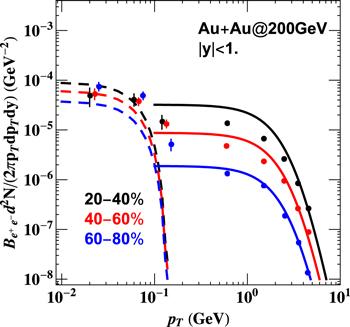 New window|Download| PPT slide
New window|Download| PPT slideFigure 4.J/ψ invariant yields for Au + Au collisions as a function of participants pT at different centralities at mid-rapidity. The dashed lines represent the photoproduction and the solid lines represent the hadroproduction. Both lines are without considering the QGP effect. Where the branching ratio ${B}_{{e}^{+}{e}^{-}}\approx 0.06$. The experimental data is from [56].
4. φ production
We now turn to studying the yield of vector meson $\phi (s\bar{s})$ in heavy-ion collisions. Based on equation (Figure 5.
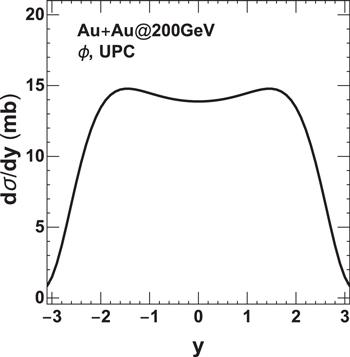 New window|Download| PPT slide
New window|Download| PPT slideFigure 5.φ meson coherent photoproduction cross section as a function of rapidity in UPC at 200 GeV Au + Au collisions.
The formula of coalescence hadronization mechanism can be expressed as,
The results are shown in figure 6. We can see the experimental data of φ mesons can be described well with the coalescence model. The photonproduced φ in the peripheral heavy-ion collisions via the Pomeron exchange process is mainly in the low pT region and smaller than coalescence production in the central and mid-rapidity. This is very different from the J/ψ that the photonproduced is significantly larger than hadroproduction. That's because the strange quark thermal production in QGP, will enhance the yield of φ in heavy-ion collisions. However, strangeness enhancement becomes weak at very peripheral collisions, such as 60%–80% as shown in figure 6. Then, the photoproduction is a little bit larger than coalescence production. That may provide an opportunity to observe the photoproduction effect.
Figure 6.
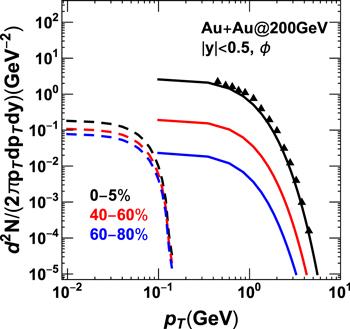 New window|Download| PPT slide
New window|Download| PPT slideFigure 6.The pT spectrum of φ meson in Au + Au collisions at 200 GeV. The dashed lines represent the photoproduction and the solid lines represent the coalescence production. The experimental data is from [67].
5. Summary
In summary, we study the production of vector meson J/ψ and φ at ultra-peripheral nuclear collisions and peripheral hadronic heavy-ion collisions which include initial production, regeneration, and photoproduction. The results show, the photoproduced J/ψs are mainly in the very low momentum range and clearly exceed the hadronic production even the regeneration supplement. Our results can explain the experimental data. However, due to the strange quark pair thermal production in quark-gluon plasma (QGP) produced in relativistic heavy-ion collisions, the photoproduced φ is usually smaller than the coalescence production and only reveals itself at very peripheral collisions. Based on this study, we can conclude that for heavy quarkonium the photoproduction is significantly dominant at the very low pT region, while strange or light flavor vector mesons are not obvious as even its photoproduction is much more than that of heavy quarkonium.Reference By original order
By published year
By cited within times
By Impact factor
DOI:10.1103/PhysRevD.85.054503 [Cited within: 1]
DOI:10.1142/S0217751X09047570 [Cited within: 1]
DOI:10.1103/PhysRevC.85.044907 [Cited within: 4]
[Cited within: 1]
DOI:10.1007/JHEP04(2013)112 [Cited within: 1]
DOI:10.1103/PhysRevD.78.074033 [Cited within: 1]
DOI:10.1088/0954-3899/39/2/025010 [Cited within: 1]
DOI:10.1103/PhysRevLett.109.202303 [Cited within: 1]
DOI:10.1103/PhysRevD.88.105017 [Cited within: 1]
DOI:10.1016/j.physletb.2017.02.046
DOI:10.1016/j.ppnp.2020.103801
[Cited within: 1]
DOI:10.1016/0370-1573(88)90142-1 [Cited within: 1]
DOI:10.1146/annurev.nucl.55.090704.151526
DOI:10.1016/j.physletb.2015.10.040
DOI:10.1103/PhysRevLett.113.232504 [Cited within: 1]
DOI:10.1103/PhysRevLett.123.132302 [Cited within: 1]
DOI:10.1016/j.nuclphysbps.2017.05.096 [Cited within: 1]
DOI:10.1103/PhysRevLett.116.222301 [Cited within: 1]
DOI:10.1007/BF03184853 [Cited within: 1]
DOI:10.1007/BF01333110 [Cited within: 1]
DOI:10.1016/S0146-6410(97)00049-5 [Cited within: 2]
DOI:10.1103/PhysRevC.60.014903 [Cited within: 2]
DOI:10.1016/j.physletb.2019.135089 [Cited within: 1]
DOI:10.1016/j.physletb.2017.12.055 [Cited within: 2]
DOI:10.1103/PhysRevC.87.032201
DOI:10.1016/j.physletb.2018.12.041
DOI:10.1103/PhysRevC.99.061901 [Cited within: 1]
DOI:10.1103/PhysRevC.95.014905 [Cited within: 1]
DOI:10.1016/j.nuclphysa.2019.06.012 [Cited within: 1]
DOI:10.1016/0550-3213(86)90164-1 [Cited within: 1]
DOI:10.1103/PhysRevD.11.3105
DOI:10.1016/0370-2693(88)90570-9
DOI:10.1016/j.nuclphysa.2011.02.032 [Cited within: 2]
DOI:10.1016/j.nuclphysa.2011.05.001 [Cited within: 2]
DOI:10.1103/PhysRevC.89.054911 [Cited within: 1]
DOI:10.1016/j.physletb.2016.12.021 [Cited within: 2]
DOI:10.1016/j.physletb.2013.09.036
DOI:10.1016/j.physletb.2020.135271 [Cited within: 1]
DOI:10.1016/j.physletb.2017.11.014 [Cited within: 2]
DOI:10.1103/PhysRevLett.48.1066 [Cited within: 1]
DOI:10.1103/PhysRevLett.48.1066 [Cited within: 1]
DOI:10.1103/PhysRevD.103.033007 [Cited within: 1]
[Cited within: 1]
DOI:10.1016/0550-3213(88)90033-8 [Cited within: 1]
DOI:10.1140/epjc/s10052-013-2335-8 [Cited within: 1]
DOI:10.1103/PhysRevC.97.044910 [Cited within: 1]
[Cited within: 1]
DOI:10.1103/PhysRevLett.98.232002 [Cited within: 1]
DOI:10.1103/PhysRevC.93.024919 [Cited within: 1]
DOI:10.1088/0954-3899/37/7/075110 [Cited within: 1]
DOI:10.1088/1674-1137/43/12/124101 [Cited within: 1]
DOI:10.1103/PhysRevC.55.392 [Cited within: 1]
DOI:10.1016/j.physletb.2011.01.026 [Cited within: 1]
DOI:10.1088/1742-6596/779/1/012039 [Cited within: 1]
DOI:10.1103/PhysRevC.93.054905 [Cited within: 1]
DOI:10.1103/PhysRevC.95.034908 [Cited within: 1]
DOI:10.1103/PhysRevC.93.055206 [Cited within: 1]
DOI:10.1103/PhysRevC.68.044902 [Cited within: 1]
DOI:10.1103/PhysRevC.68.034904
DOI:10.1140/epjc/s10052-018-5828-7 [Cited within: 2]
DOI:10.1103/PhysRevLett.91.092301 [Cited within: 1]
DOI:10.1103/PhysRevLett.89.202302 [Cited within: 1]
DOI:10.1103/PhysRevC.67.034902 [Cited within: 1]
DOI:10.1142/S0218301317500811 [Cited within: 1]
DOI:10.1103/PhysRevC.72.014903 [Cited within: 1]
